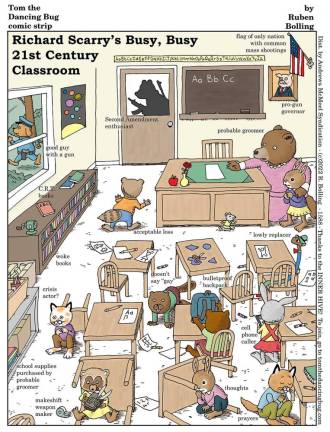Does the name Ken Fisher mean anything to you? Okay, how about Ruben Bolling? Finally, how about Tom the Dancing Bug? They are all one and the same. I didn’t know that either.
It turns out that Fisher, a long time Upper East Sider, is a highly successful editorial cartoonist. He chose Ruben Bolling as his AKA when he was in law school and thought his rather daring cartoons should stay anonymous. (“It was based on my shyness,” he laughs, so he grabbed the names of two minor league baseball players.) And Tom the Dancing Bug? That’s the title of the weekly cartoon that has brought him multiple awards, financial security, and thousands of fans.
But let’s go back. The middle of three brothers, he attended New York schools, then Tufts, and finally, Harvard Law School. There, he started submitting cartoons to the school paper. And that’s where Harvard’s legendary professor, Laurence Tribe, jotted “Ruben” a note, saying, “you are heading to the wrong profession.” As in the Law. Fisher did get that degree and worked in the legal and financial world for several years, but then the passion for the cartoon world took over and as he says, “I found my voice and my career began.” Ruben Bolling was officially born.
Tom The Dancing Bug — which is compared to “Saturday Night Live’s” sketch style — started in alternative papers like the Village Voice, but eventually was published in all the important publications— including the New York Times, the Washington Post, and The New Yorker. The latter gave him a full page and was interested in bringing “Bolling” on full time. But a long discussion with a copy editor about the use of one word (Holocaust) signaled how much editing he would be dealing with at the prestigious periodical. He chose to remain freelance.
“One of my most exciting days,” he recalls, “was walking by a newsstand and seeing the New Yorker, The Wall St. Journal ,and the NY Times, knowing I had a cartoon in each of them that week.”
The Inner Hive
As newspapers dwindled, the Internet became home for that dancing bug and now, you too can join the Inner Hive, the subscription service which sends Bolling’s recurring characters, such as Lucky Ducky, Nate the Neo-Conservative and others as soon as they are drawn. It is wildly popular.
The comic strip’s content has changed over the years. “When it started, it was apolitical,” its creator says. “By the aftermath of 9/11, more than half had a political nature. And at the rise of Trump, and ever since, it has been almost 90% about topical issues. Though to say Trump was good for my business would be churlish.”
But true. And recognized. In 2017, he received The National Cartoonist Society Award and a Herblock Prize (named after one of his idols). He is proud and surprised by his 2018 Robert F. Kennedy Journalism Award and was a finalist for the Pulitzer Prize in 2019 and 2021.
The cartoonist has no regrets about leaving the worlds of law and finance, “though I admit I don’t always like the loneliness of the cartoonist life,” he says. But family is near and close. His parents – at 86 and 92 sharp and delightful – live nearby, and he is a devoted father to his three children. He once hosted a panel on cartooning at the Brearley School (where his daughters attended), which included Roz Chast and other well-known names in his field. His son, Jake, won $125,000 as a winner of NBC’s recently rebooted “College Bowl.”
Speaking of students, his recent and possibly most powerful cartoon went viral right after the Uvalde shooting. A well-known children’s book became the perfect symbol of lost innocence in today’s classrooms.
The cartoonist’s own latest book, available on Amazon, is out as well, a collection of his more recent works. It is called “Eat the Poor.” I can’t wait to see what that means.
Michele Willens’ essay collection, “From Mouseketeers to Menopause,” is available on Amazon.

